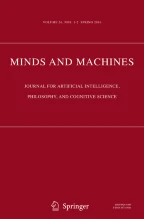747Accesses
39Citations
3 Altmetric
Abstract
Computation is interpretable symbol manipulation. Symbols are objects that are manipulated on the basis of rules operating only on theirshapes, which are arbitrary in relation to what they can be interpreted as meaning. Even if one accepts the Church/Turing Thesis that computation is unique, universal and very near omnipotent, not everything is a computer, because not everything can be given a systematic interpretation; and certainly everything can't be givenevery systematic interpretation. But even after computers and computation have been successfully distinguished from other kinds of things, mental states will not just be the implementations of the right symbol systems, because of the symbol grounding problem: The interpretation of a symbol system is not intrinsic to the system; it is projected onto it by the interpreter. This is not true of our thoughts. We must accordingly be more than just computers. My guess is that the meanings of our symbols are grounded in the substrate of our robotic capacity to interact with that real world of objects, events and states of affairs that our symbols are systematically interpretable as being about.
This is a preview of subscription content,log in via an institution to check access.
Access this article
Subscribe and save
- Starting from 10 chapters or articles per month
- Access and download chapters and articles from more than 300k books and 2,500 journals
- Cancel anytime
Buy Now
Price includes VAT (Japan)
Instant access to the full article PDF.
Similar content being viewed by others
Explore related subjects
Discover the latest articles, books and news in related subjects, suggested using machine learning.References
Andrews, J., Livingston, K., Harnad, S., and Fischer, U. (in prep.) ‘Categorical Perception Induced by Learning’.
Church, A. (1956),Introduction to Mathematical Logic, Princeton, Princeton University Press.
Dietrich, E. (1990), ‘Computationalism’,Social Epistemology4, 135–154.
Fodor, J. A. (1975),The Language of Thought, New York: Thomas Y. Crowell.
Fodor, J. A., and Pylyshyn, Z. W. (1988), ‘Connectionism and Cognitive Architecture: A Critical Appraisal,Cognition28, 3–71.
Galton, A. (1990), ‘The Church-Turing Thesis: Its Nature and Status’,AISB Quarterly,74, 9–19.
Harnad, S. (1982), ‘Consciousness: An Afterthought’,Cognition and Brain Theory5, 29–47.
Harnad, S. (ed.) (1987),Categorical Perception: The Groundwork of Cognition, New York: Cambridge University Press.
Harnad, S. (1989), ‘Minds, Machines and Searle’,Journal of Theoretical and Experimental Artificial Intelligence1, 5–25.
Harnad, S. (1990a), ‘The Symbol Grounding Problem’,Physica D42, 335–346.
Harnad, S. (1990b), ‘Against Computational Hermeneutics’, (Invited Commentary on Eric Dietrich's Computationalism),Social Epistemology4, 167–172.
Harnad, S. (1990c), ‘Lost in the Hermeneutic Hall of Mirrors’, (Invited Commentary on: Michael Dyer) Minds, Machines, Searle and Harnad.Journal of Experimental and Theoretical Artificial Intelligence2, 321–327.
Harnad, S. (1991), ‘Other Bodies, Other Minds: A Machine Incarnation of an Old Philosophical Problem’,Minds and Machines1, 43–54.
Harnad, S. (1992a), ‘Connecting Object to Symbol in Modeling Cognition’, in A. Clarke and R. Lutz (eds.),Connectionism in Context, Springer Verlag, Berlin.
Harnad, S. (1992b). ‘The Turing Test is not a Trick: Turing Indistinguishability is a Scientific Criterion’,SIGART Bulletin3(4), 9–10.
Harnad, S. (1993a), ‘Grounding Symbols in the Analog World with Neural Nets’,Think2(1), 12–78 (Special issue on “Connectionism versus Symbolism,” D. M. W. Powers and P. A. Flach, eds.).
Harnad, S. (1993b), ‘Artificial Life: Synthetic Versus Virtual’,Artificial Life III. Proceedings, Santa Fe Institute Studies in the Sciences of Complexity. Volume XVI.
Harnad, S. (1993c), ‘Problems, Problems: The Frame Problem as a Symptom of the Symbol Grounding Problem’,PSYCOLOQUY4(34), frame-problem.11.
Harnad, S. (1993d), ‘Grounding Symbolic Capacity in Robotic Capacity’, in Steels, L. and R. Brooks (eds.),The “Artificial Life” route to “Artificial Intelligence”, Building Situated Embodied Agents. New Haven: Lawrence Erlbaum.
Harnad, S. (1994a), ‘The Origin of Words: A Psychophysical Hypothesis’, in Durham, W. and Velichkovsky, B. (eds.),Naturally Human: Origins and Destiny of Language, Muenster: Nodus Pub.
Harnad, S. (1994b), ‘Levels of Functional Equivalence in Reverse Bioengineering: The Darwinian Turing Test for Artificial Life’,Artificial Life1(3), 293–301.
Harnad, S., Hanson, S.J., and Lubin, J. (1991), ‘Categorical Perception and the Evolution of Supervised Learning in Neural Nets’, in D. W. Powers and L. Reeker (eds.) Working Papers of the AAAI Spring Symposium on Machine Learning of Natural Language and Ontology, pp. 65–74. (Presented at Symposium on Symbol Grounding: Problems and Practice, Stanford University, March 1991; also reprinted as Document D91-09, Deutsches Forschungszentrum fur Kuenstliche Intelligenz GmbH Kaiserslautern FRG).
Harnad, S. Hanson, S.J., and Lubin, J. (1994), ‘Learned Categorical Perception in Neural Nets: Implications for Symbol Grounding, in V. Honavar and L. Uhr (eds.),Symbol Processors and Connectionist Network Models in Artificial Intelligence and Cognitive Modelling: Steps Toward Principled Integration, pp. 191–206. Academic Press.
Hayes, P., Harnad, S., Perlis, D., and Block, N. (1992), ‘Virtual Symposium on Virtual Mind’,Minds and Machines2, 217–238.
Nagel, T. (1974), ‘What is it Like to be a Bat?’,Philosophical Review83, 435–451.
Nagel, T. (1986), ‘The View From Nowhere, New York: Oxford University Press.
Newell, A. (1980), ‘Physical Symbol Systems’,Cognitive Science4, 135–83.
Pylyshyn, Z. W. (1984),Computation and Cognition, Cambridge MA: MIT/Bradford.
Searle, J. R. (1980), ‘Minds, Brains and Programs’,Behavioral and Brain Sciences3, 417–424.
Turing, A. M. (1964), ‘Computing Machinery and Intelligence’, inMinds and Machines, A. Anderson (ed.), Engelwood Cliffs NJ: Prentice Hall.
Turing, A. M. (1990), ‘Mechanical Intelligence’ (D. C. Ince, ed.), North Holland, Amsterdam.
Author information
Authors and Affiliations
Department of Psychology, University of Southampton, Highfield, SO17 1BJ, Southampton, UK
Stevan Harnad
- Stevan Harnad
Search author on:PubMed Google Scholar
Rights and permissions
About this article
Cite this article
Harnad, S. Computation is just interpretable symbol manipulation; cognition isn't.Mind Mach4, 379–390 (1994). https://doi.org/10.1007/BF00974165
Issue date:
Share this article
Anyone you share the following link with will be able to read this content:
Sorry, a shareable link is not currently available for this article.
Provided by the Springer Nature SharedIt content-sharing initiative


